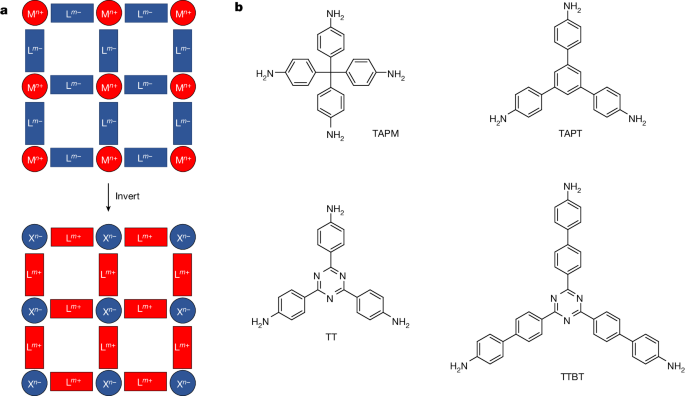Designing Porous Non-Metal Organic Frameworks through Computational Crystal Structure Prediction
Core Concepts
Combining chemical knowledge and computational crystal structure prediction, the authors designed porous organic ammonium halide salt frameworks that contain no metals, demonstrating the potential to create a family of non-metal organic frameworks with high ionic charge density and permanent porosity.
Abstract
The content discusses the development of porous organic ammonium halide salt frameworks, which are a new class of crystalline materials that do not contain metal nodes. The authors leveraged computational crystal structure prediction techniques to design these porous salt frameworks, which are built from tightly packed ionic clusters that direct the materials to crystallize in specific ways.
The key highlights are:
Metal-organic frameworks (MOFs) are successful synthetic materials, but their isoreticular strategies do not translate well to other crystalline solids like organic salts.
The authors combined chemical knowledge with computational crystal structure prediction to design porous organic ammonium halide salt frameworks that contain no metals.
The ionic clusters in these salt frameworks act as the nodes, directing the materials to form well-defined spikes of low-energy, low-density isoreticular structures on the predicted lattice energy landscapes.
These energy landscapes allow the authors to select cation-anion combinations that will form thermodynamically stable, porous salt frameworks with predictable channel sizes, functionalities, and geometries.
Some of these porous salts can adsorb molecular guests like iodine in quantities exceeding most MOFs, which could be useful for applications like radio-iodine capture.
The synthesis of these salts is scalable, involving simple acid-base neutralization, and the strategy enables the creation of a family of non-metal organic frameworks with high ionic charge density and permanent porosity.
Porous isoreticular non-metal organic frameworks - Nature
Stats
The porous organic ammonium halide salt frameworks can adsorb molecular guests like iodine in quantities that exceed those of most metal-organic frameworks.
Quotes
"Here we show that chemical knowledge can be combined with computational crystal-structure prediction6 (CSP) to design porous organic ammonium halide salts that contain no metals."
"The nodes in these salt frameworks are tightly packed ionic clusters that direct the materials to crystallize in specific ways, as demonstrated by the presence of well-defined spikes of low-energy, low-density isoreticular structures on the predicted lattice energy landscapes7,8."
"Some of these porous salts adsorb molecular guests such as iodine in quantities that exceed those of most MOFs, and this could be useful for applications such as radio-iodine capture9,10,11,12."
Key Insights Distilled From
by Mega... at www.nature.com 05-22-2024
https://www.nature.com/articles/s41586-024-07353-9
Deeper Inquiries
How can the computational crystal structure prediction techniques used in this work be further improved or expanded to design an even wider range of porous non-metal organic frameworks?
In order to enhance the computational crystal structure prediction techniques for designing a broader array of porous non-metal organic frameworks, several strategies can be implemented:
Incorporation of Machine Learning: Integrate machine learning algorithms to analyze a larger dataset of known structures and predict potential configurations for new frameworks.
Consideration of Guest Molecules: Include the presence of guest molecules in the prediction models to account for their impact on the final framework structure.
Exploration of Diverse Linker Functionalities: Expand the library of organic linkers with varied functionalities to enable the creation of frameworks with tailored properties.
Incorporation of Solvent Effects: Account for the influence of solvents during the crystallization process to predict the formation of stable frameworks under different conditions.
Validation through Experimental Synthesis: Validate the predicted structures through experimental synthesis to refine the prediction models and improve accuracy.
What are the potential limitations or drawbacks of using organic ammonium halide salts as the building blocks for porous frameworks compared to metal-organic frameworks?
While organic ammonium halide salts offer unique advantages for porous frameworks, they also present certain limitations:
Ionic Instability: Organic salts may exhibit lower thermal and chemical stability compared to metal-organic frameworks, limiting their applicability in harsh environments.
Limited Diversity: The range of possible organic cations and anions for salt frameworks may be more restricted than the variety of metal nodes and organic linkers available for MOFs, potentially limiting structural diversity.
Synthesis Complexity: The synthesis of organic ammonium halide salts may involve more intricate procedures compared to the simpler assembly of metal-organic frameworks, leading to challenges in scalability and reproducibility.
Guest Molecule Interactions: The interactions between guest molecules and organic salts may differ from those in MOFs, affecting adsorption capacities and selectivity in certain applications.
What other types of applications, beyond radio-iodine capture, could these porous non-metal organic frameworks be useful for, and how might their properties be tailored to optimize performance in those applications?
Porous non-metal organic frameworks have the potential for various applications beyond radio-iodine capture, including:
Gas Separation: Tailoring the pore size and surface chemistry of the frameworks to selectively adsorb gases for applications in gas separation processes.
Catalysis: Modifying the framework composition to incorporate catalytic sites for reactions such as hydrogenation or oxidation.
Sensing: Designing frameworks with specific functionalities to detect and capture target molecules for sensing applications.
Drug Delivery: Engineering frameworks with controlled release properties for drug delivery systems by adjusting pore sizes and guest molecule interactions.
To optimize performance in these applications, properties of the frameworks can be tailored by adjusting pore size distribution, surface area, and functional groups to enhance adsorption capacities, selectivity, and stability in the desired environment.
0
